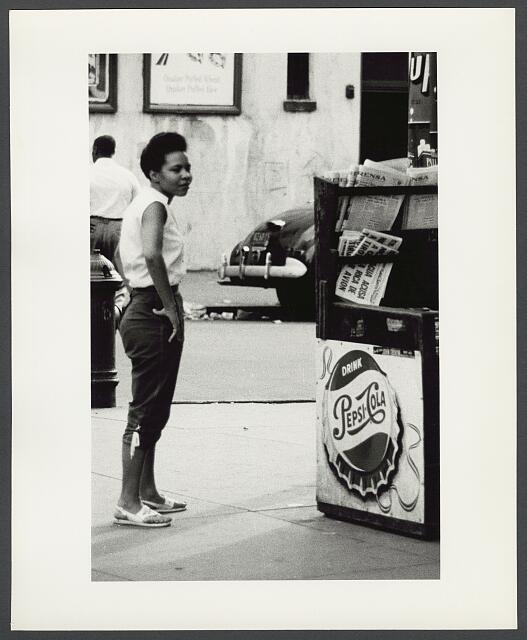Teach This Poem, though developed with a classroom in mind, can be easily adapted for remote learning, hybrid learning models, or in-person classes. Please see our suggestions for how to adapt this lesson for remote or blended learning. We have also noted suggestions when applicable and will continue to add to these suggestions online.

Rizzuto, Angelo, photographer. Woman by a Newsstand. United States New York New York State, 1954. [08/54] Photograph. https://www.loc.gov/item/2020636126/.
The following activities and questions are designed to help your students use their noticing skills to move through the poem and develop their thinking about its meaning with confidence, using what they’ve noticed as evidence for their interpretations. Read more about the framework upon which these activities are based.
-
Warm-up: Make a list of places that make you who you are or places that are personally meaningful to you. If you feel comfortable, share your list with a partner or small group of classmates.
-
Before Reading the Poem: Look at this photograph. What do you notice in the image? Look again. What else do you see, and what makes you say that? What do you think the woman is doing? How does she feel? Use details from the photograph to support your observations.
-
Reading the Poem: Read the poem “Asi” by Claudia Castro Luna silently. What do you notice about the poem? Annotate for any words or phrases that stand out to you or any questions you might have.
-
Listening to the Poem: (enlist two volunteers to read the poem aloud): Listen as the poem is read aloud twice, and write down any additional words and phrases that stand out to you. Or, you may opt to watch the video of the poet reading the poem.
-
Small-group Discussion: Share what you noticed in the poem with a small group of students. Based on the details you just shared with your small group, and your observations from the beginning of class, what role does place play for the speaker? Why? What role does place for you?
-
Whole-class Discussion: In this poem, how does the speaker “take space”? Read the first letter on this page from the poet. How does this letter change your understanding of the poem? What questions do you still have?
-
Extension for Grades 7-8: Below the letter you just read, continue to browse the letters that students wrote to Claudia Castro Luna during Dear Poet 2020. Even though this poem was featured in last year’s Dear Poet Project, write a letter to Claudia Castro Luna with your questions from the discussion and your reactions to this poem.
-
Extension for Grades 9-12: Claudia Castro Luna’s poems often explore place. Read more of Castro Luna’s work and then write your own poem, essay, or response to a place that is personally meaningful for you.
As the poet laureate of Washington State and an Academy of American Poets Poet Laureate Fellow, Claudia Castro Luna convened One River, Many Voices, a series of poetry writing workshops and readings along the entire length of the Columbia River, from the point it enters the northeastern corner of Washington to its encounter with the Pacific Ocean, to highlight the importance of this natural resource. Read more about the project here.
